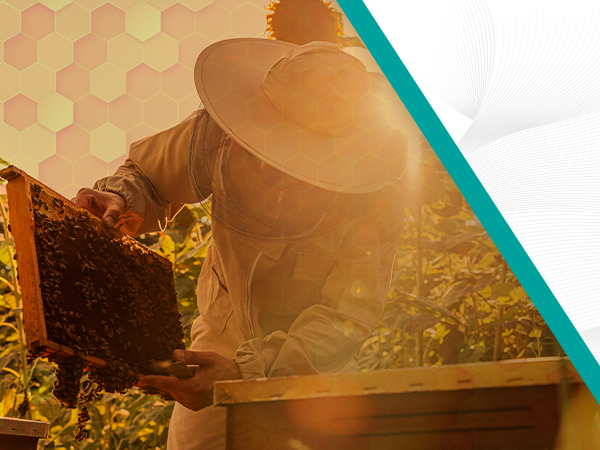Keep an Eye Out: New Trends in the AG Industry 2023 is rolling to an end, but industry advancements and changes remain …


The Bee Effect: Keeping the World Abuzz
We have all heard about the “butterfly effect” -a concept in chaos theory which states that small causes can have large effects. The name originated from the idea that a butterfly flapping its wings in one part of the world could set off a chain of events that ultimately leads to a hurricane in another part of the world. However, when it comes to environmental stability it is not a butterfly that would have the greatest level of impact.
Bees are one of the most important creatures in our ecosystem. They play a critical role in the natural pollination process, the primary mean in which plants reproduce. Although some species can be wind-pollinated, and other pollinators do the job as well, none is as well suited for the task as bees, due to the fact that they are able to visit – and pollinize – large numbers of flowers in a relatively short period of time.
Impact in agriculture
Animal pollinators are responsible for almost ¾ of the global flowering plants and take on 35% of the world’s crops. To better understand their impact, scientists estimate that one in every three bites of our food comes from an animal-pollinated source.
Of the many pollinators that help in this process— such as birds, butterflies, moths, and bats—, the one that takes the honey-cake as the primary commercial pollinator is the bee, and, more specifically among the over 4,000 types that exist in the US, the honeybee. Honeybees are the only species that produce honey for human consumption, with a single honeybee only making about ¹⁄₁₂ of a teaspoon of honey in its entire lifetime. They are social insects with a complex communication system that involves dancing to convey information about the location of food sources and other important information, and they live and interact in highly organized colonies, each typically consisting of a queen, drones, and worker bees.
Amid the many crops that are possible thanks to their intervention, we can count almonds, squash, and non-citrus fruit trees. There are also many derived products that are part of the economic chain, such as beeswax, propolis, pollen and royal jelly, generally used in beauty and pharmaceutical products on account of their many natural benefits, some of which include moisturizing, analgesic, antifungal, antimicrobial, and antioxidant properties.
Despite their importance and vital part in the food chain, bee populations have been declining, mainly due to habitat loss, pesticide use, and diseases. The latter can be attributed to bacteria (American foulbrood), viruses (chronic bee paralysis, deformed wing virus), and parasites (acarapiosis, small hive beetle infestation, varroatosis) among other sources, and it greatly impacts the balance within the hives. Although the exact cause is yet undetermined, one of the most notorious consequences is the Colony Collapse Disorder, in which worker bees abandon the queen and the hive, eventually causing the disappearance of the colony as a whole.
As bees struggle to survive, the impact on agriculture could be significant. If bee populations continue to decline, we could be facing lower crop yields, higher food prices, reduction of biodiversity and nutritional quality, and, eventually, food scarcity.
What can we do?
Focusing efforts on environmental and animal protection is now a priority for many countries, including the US. However, we can also create a butterfly effect and be the small cause that enacts the mayor change.
- Create bee-friendly spaces: planting wildflowers and other native plants can provide shelter, habitat, and food to bees. You don’t even need to go too big; just choose some that would drive their attention, like bright yellow sunflowers and calendula, purple salvia, or even lavender and rosemary. Having apiaries is also a great alternative to help the species reproduce and get some fresh honey for yourself!
- Reduce pesticide: These products can directly impact memory, bee reproduction, and overall hive health. If you need to use them, make sure to choose formulations that are less toxic and application methods that are friendlier to bees.
- Support organizations and small businesses dedicated to bee conservation: if you are not able to have apiaries on your farm, make a mental note to always purchase honey and other bee products from local beekeepers. This will also strengthen local economy by creating new jobs and promoting healthy ecosystems. You can also help conservation organizations by supporting their efforts and learn how you can better adapt your practices to be more bee friendly.
The Viscosity commitment
At VISCOSITY Oil we are, like bees, tirelessly working to perfect the formulations that will keep your equipment on the move, constantly striving for that balance between effectiveness and protection. We want you to continue working in fluid motion with outstanding products that will drive your business forward! Remember to check our new online store and follow us on Facebook and Instagram to stay connected with our latest news. Keep your farm abuzz with VISCOSITY Oil, formulated for ALL!
RELATED ARTICLES
Harvesting Success: Crop Rotation and Cover Crops Crop rotation and the use of cover crops are key tools for sustainable farming practices …

